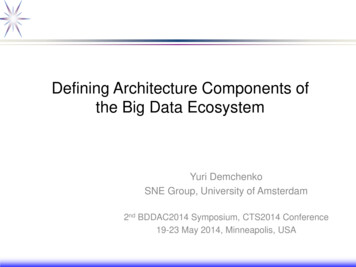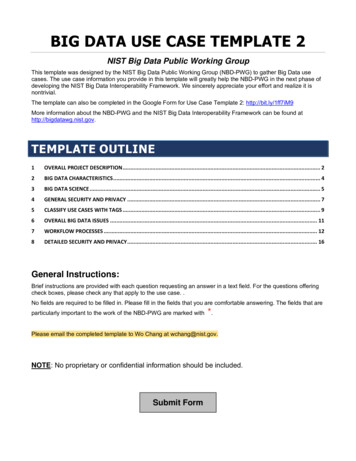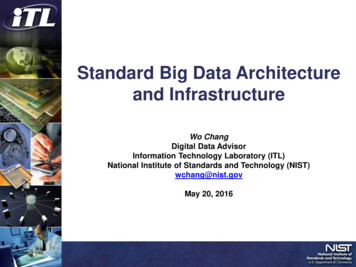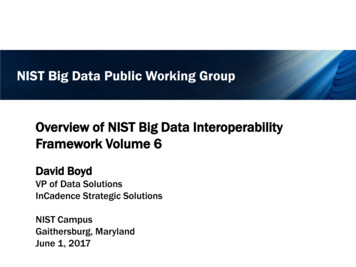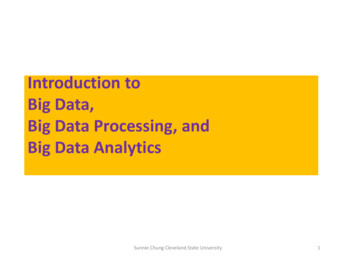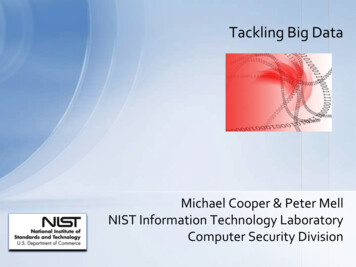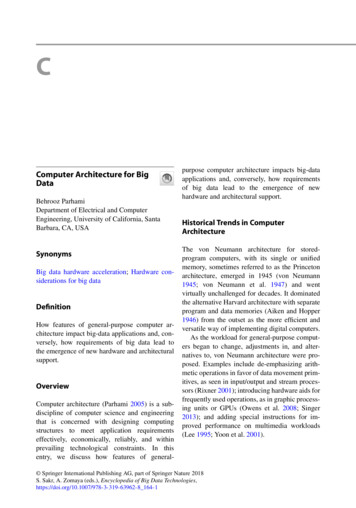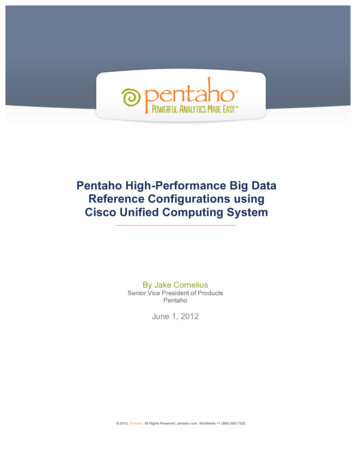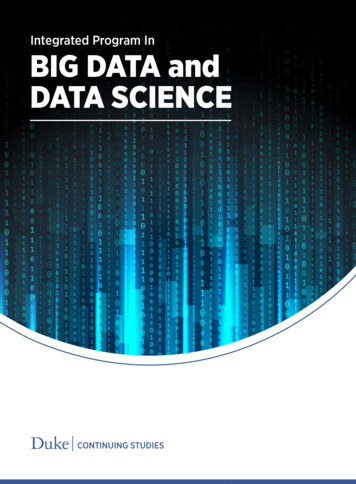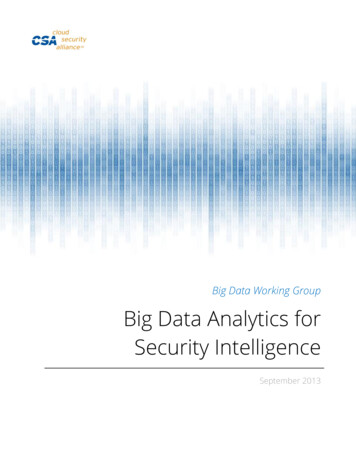
Transcription
Big Data Working GroupBig Data Analytics forSecurity IntelligenceSeptember 2013
CLOUD SECURITY ALLIANCE Big Data Analytics for Security Intelligencev 2013 Cloud Security Alliance – All Rights ReservedAll rights reserved. You may download, store, display on your computer, view, print, and link to the CloudSecurity Alliance Big Data Analytics for Security Intelligence at bject to the following: (a) the Document may be used solely for your personal, informational, non-commercialuse; (b) the Document may not be modified or altered in any way; (c) the Document may not be redistributed;and (d) the trademark, copyright or other notices may not be removed. You may quote portions of theDocument as permitted by the Fair Use provisions of the United States Copyright Act, provided that youattribute the portions to the Cloud Security Alliance Big Data Analytics for Security Intelligence (2013). 2013 Cloud Security Alliance - All Rights Reserved.2
CLOUD SECURITY ALLIANCE Big Data Analytics for Security IntelligencevContentsAcknowledgments . 41.0 Introduction . 52.0 Big Data Analytics . 62.1 Data Privacy and Governance. 103.0 Big Data Analytics for Security. 104.0 Examples . 114.1 Network Security . 114.2 Enterprise Events Analytics . 124.3 Netflow Monitoring to Identify Botnets . 134.4 Advanced Persistent Threats Detection . 144.4.1 Beehive: Behavior Profiling for APT Detection . 154.4.2 Using Large-Scale Distributed Computing to Unveil APTs . 165.0 The WINE Platform for Experimenting with Big Data Analytics in Security . 175.1 Data Sharing and Provenance . 175.2 WINE Analysis Example: Determining the Duration of Zero-Day Attacks . 186.0 Conclusions . 19Bibliography . 21 2013 Cloud Security Alliance - All Rights Reserved.3
CLOUD SECURITY ALLIANCE Big Data Analytics for Security IntelligencevAcknowledgmentsEditors:Alvaro A. Cárdenas, University of Texas at DallasPratyusa K. Manadhata, HP LabsSree Rajan, Fujitsu Laboratories of AmericaContributors:Alvaro A. Cárdenas, University of Texas at DallasTudor Dumitras, University of Maryland, College ParkThomas Engel, University of LuxembourgJérôme François, University of LuxembourgPaul Giura, AT&TAri Juels, RSA LaboratoriesPratyusa K. Manadhata, HP LabsAlina Oprea, RSA LaboratoriesCathryn Ploehn, University of Texas at DallasRadu State, University of LuxembourgGrace St. Clair, University of Texas at DallasWei Wang, AT&TTing-Fang Yen, RSA LaboratoriesCSA Staff:Alexander Ginsburg, CopyeditorLuciano JR Santos, Global Research DirectorKendall Scoboria, Graphic DesignerEvan Scoboria, WebmasterJohn Yeoh, Research Analyst 2013 Cloud Security Alliance - All Rights Reserved.4
CLOUD SECURITY ALLIANCE Big Data Analytics for Security Intelligencev1.0 IntroductionFigure 1. Big Data differentiatorsThe term Big Data refers to large-scale information management and analysis technologies that exceed thecapability of traditional data processing technologies.1 Big Data is differentiated from traditional technologies inthree ways: the amount of data (volume), the rate of data generation and transmission (velocity), and the typesof structured and unstructured data (variety) (Laney, 2001) (Figure 1).1http://gartner.com/it-glossary/big-data/ 2013 Cloud Security Alliance - All Rights Reserved.5
CLOUD SECURITY ALLIANCE Big Data Analytics for Security IntelligencevHuman beings now create 2.5 quintillion bytes of data per day. The rate of data creation has increased so muchthat 90% of the data in the world today has been created in the last two years alone. 2 This acceleration in theproduction of information has created a need for new technologies to analyze massive data sets. The urgency forcollaborative research on Big Data topics is underscored by the U.S. federal government’s recent 200 millionfunding initiative to support Big Data research.3This document describes how the incorporation of Big Data is changing security analytics by providing new toolsand opportunities for leveraging large quantities of structured and unstructured data. The remainder of thisdocument is organized as follows: Section 2 highlights the differences between traditional analytics and Big Dataanalytics, and briefly discusses tools used in Big Data analytics. Section 3 reviews the impact of Big Data analyticson security and Section 4 provides examples of Big Data usage in security contexts. Section 5 describes a platformfor experimentation on anti-virus telemetry data. Finally, Section 6 proposes a series of open questions about therole of Big Data in security analytics.2.0 Big Data AnalyticsBig Data analytics – the process of analyzing and mining Big Data – can produce operational and businessknowledge at an unprecedented scale and specificity. The need to analyze and leverage trend data collected bybusinesses is one of the main drivers for Big Data analysis tools.The technological advances in storage, processing, and analysis of Big Data include (a) the rapidly decreasing costof storage and CPU power in recent years; (b) the flexibility and cost-effectiveness of datacenters and cloudcomputing for elastic computation and storage; and (c) the development of new frameworks such as Hadoop,which allow users to take advantage of these distributed computing systems storing large quantities of datathrough flexible parallel processing. These advances have created several differences between traditionalanalytics and Big Data analytics (Figure -research-will-aim-at-flood-of-digital-data.html 2013 Cloud Security Alliance - All Rights Reserved.6
CLOUD SECURITY ALLIANCE Big Data Analytics for Security IntelligencevFigure 2. Technical factors driving Big Data adoption1. Storage cost has dramatically decreased in the last few years. Therefore, while traditional data warehouseoperations retained data for a specific time interval, Big Data applications retain data indefinitely tounderstand long historical trends.2. Big Data tools such as the Hadoop ecosystem and NoSQL databases provide the technology to increasethe processing speed of complex queries and analytics.3. Extract, Transform, and Load (ETL) in traditional data warehouses is rigid because users have to defineschemas ahead of time. As a result, after a data warehouse has been deployed, incorporating a newschema might be difficult. With Big Data tools, users do not have to use predefined formats. They can loadstructured and unstructured data in a variety of formats and can choose how best to use the data.Big Data technologies can be divided into two groups: batch processing, which are analytics on data at rest, andstream processing, which are analytics on data in motion (Figure 3). Real-time processing does not always needto reside in memory, and new interactive analyses of large-scale data sets through new technologies like Drill andDremel provide new paradigms for data analysis; however, Figure 1 still represents the general trend of thesetechnologies. 2013 Cloud Security Alliance - All Rights Reserved.7
CLOUD SECURITY ALLIANCE Big Data Analytics for Security IntelligencevFigure 3. Batch and stream processingHadoop is one of the most popular technologies for batch processing. The Hadoop framework provides developerswith the Hadoop Distributed File System for storing large files and the MapReduce programming model (Figure 4),which is tailored for frequently occurring large-scale data processing problems that can be distributed andparallelized. 2013 Cloud Security Alliance - All Rights Reserved.8
CLOUD SECURITY ALLIANCE Big Data Analytics for Security IntelligencevFigure 4. Illustration of MapReduceSeveral tools can help analysts create complex queries and run machine learning algorithms on top of Hadoop.These tools include Pig (a platform and a scripting language for complex queries), Hive (an SQL-friendly querylanguage), and Mahout and RHadoop (data mining and machine learning algorithms for Hadoop). Newframeworks such as Spark 4 were designed to improve the efficiency of data mining and machine learningalgorithms that repeatedly reuse a working set of data, thus improving the efficiency of advanced data analyticsalgorithms.There are also several databases designed specifically for efficient storage and query of Big Data, includingCassandra, CouchDB, Greenplum Database, HBase, MongoDB, and Vertica.Stream processing does not have a single dominant technology like Hadoop, but is a growing area of research anddevelopment (Cugola & Margara 2012). One of the models for stream processing is Complex Event Processing(Luckham 2002), which considers information flow as notifications of events (patterns) that need to be aggregatedand combined to produce high-level events. Other particular implementations of stream technologies includeInfoSphere Streams5, Jubatus6, and 5 2013 Cloud Security Alliance - All Rights Reserved.9
CLOUD SECURITY ALLIANCE Big Data Analytics for Security Intelligencev2.1 Data Privacy and GovernanceThe preservation of privacy largely relies on technological limitations on the ability to extract, analyze, andcorrelate potentially sensitive data sets. However, advances in Big Data analytics provide tools to extract andutilize this data, making violations of privacy easier. As a result, along with developing Big Data tools, it is necessaryto create safeguards to prevent abuse (Bryant, Katz, & Lazowska, 2008).In addition to privacy, data used for analytics may include regulated information or intellectual property. Systemarchitects must ensure that the data is protected and used only according to regulations.The scope of this document is on how Big Data can improve information security best practices. CSA is committedto also identifying the best practices in Big Data privacy and increasing awareness of the threat to privateinformation. CSA has specific working groups on Big Data privacy and Data Governance, and we will be producingwhite papers in these areas with a more detailed analysis of privacy issues.3.0 Big Data Analytics for SecurityThis section explains how Big Data is changing the analytics landscape. In particular, Big Data analytics can beleveraged to improve information security and situational awareness. For example, Big Data analytics can beemployed to analyze financial transactions, log files, and network traffic to identify anomalies and suspiciousactivities, and to correlate multiple sources of information into a coherent view.Data-driven information security dates back to bank fraud detection and anomaly-based intrusion detectionsystems. Fraud detection is one of the most visible uses for Big Data analytics. Credit card companies haveconducted fraud detection for decades. However, the custom-built infrastructure to mine Big Data for frauddetection was not economical to adapt for other fraud detection uses. Off-the-shelf Big Data tools and techniquesare now bringing attention to analytics for fraud detection in healthcare, insurance, and other fields.In the context of data analytics for intrusion detection, the following evolution is anticipated: 1st generation: Intrusion detection systems – Security architects realized the need for layered security (e.g.,reactive security and breach response) because a system with 100% protective security is impossible.2nd generation: Security information and event management (SIEM) – Managing alerts from differentintrusion detection sensors and rules was a big challenge in enterprise settings. SIEM systems aggregateand filter alarms from many sources and present actionable information to security analysts.3rd generation: Big Data analytics in security (2nd generation SIEM) – Big Data tools have the potential toprovide a significant advance in actionable security intelligence by reducing the time for correlating,consolidating, and contextualizing diverse security event information, and also for correlating long-termhistorical data for forensic purposes. 2013 Cloud Security Alliance - All Rights Reserved.10
CLOUD SECURITY ALLIANCE Big Data Analytics for Security IntelligencevAnalyzing logs, network packets, and system events for forensics and intrusion detection has traditionally been asignificant problem; however, traditional technologies fail to provide the tools to support long-term, large-scaleanalytics for several reasons:1. Storing and retaining a large quantity of data was not economically feasible. As a result, most event logsand other recorded computer activity were deleted after a fixed retention period (e.g., 60 days).2. Performing analytics and complex queries on large, structured data sets was inefficient becausetraditional tools did not leverage Big Data technologies.3. Traditional tools were not designed to analyze and manage unstructured data. As a result, traditional toolshad rigid, defined schemas. Big Data tools (e.g., Piglatin scripts and regular expressions) can query data inflexible formats.4. Big Data systems use cluster computing infrastructures. As a result, the systems are more reliable andavailable, and provide guarantees that queries on the systems are processed to completion.New Big Data technologies, such as databases related to the Hadoop ecosystem and stream processing, areenabling the storage and analysis of large heterogeneous data sets at an unprecedented scale and speed. Thesetechnologies will transform security analytics by: (a) collecting data at a massive scale from many internalenterprise sources and external sources such as vulnerability databases; (b) performing deeper analytics on thedata; (c) providing a consolidated view of security-related information; and (d) achieving real-time analysis ofstreaming data. It is important to note that Big Data tools still require system architects and analysts to have adeep knowledge of their system in order to properly configure the Big Data analysis tools.4.0 ExamplesThis section describes examples of Big Data analytics used for security purposes.4.1 Network SecurityIn a recently published case study, Zions Bancorporation8 announced that it is using Hadoop clusters and businessintelligence tools to parse more data more quickly than with traditional SIEM tools. In their experience, thequantity of data and the frequency analysis of events are too much for traditional SIEMs to handle alone. In theirtraditional systems, searching among a month’s load of data could take between 20 minutes and an hour. In theirnew Hadoop system running queries with Hive, they get the same results in about one ity-big-dataanalysis.html 2013 Cloud Security Alliance - All Rights Reserved.11
CLOUD SECURITY ALLIANCE Big Data Analytics for Security IntelligencevThe security data warehouse driving this implementation not only enables users to mine meaningful securityinformation from sources such as firewalls and security devices, but also from website traffic, business processesand other day-to-day transactions.10 This incorporation of unstructured data and multiple disparate data sets intoa single analytical framework is one of the main promises of Big Data.4.2 Enterprise Events AnalyticsEnterprises routinely collect terabytes of security relevant data (e.g., network events, software application events,and people action events) for several reasons, including the need for regulatory compliance and post-hoc forensicanalysis. Unfortunately, this volume of data quickly becomes overwhelming. Enterprises can barely store the data,much less do anything useful with it. For example, it is estimated that an enterprise as large as HP currently (in2013) generates 1 trillion events per day, or roughly 12 million events per second. These numbers will grow asenterprises enable event logging in more sources, hire more employees, deploy more devices, and run moresoftware. Existing analytical techniques do not work well at this scale and typically produce so many false positivesthat their efficacy is undermined. The problem becomes worse as enterprises move to cloud architectures andcollect much more data. As a result, the more data that is collected, the less actionable information is derivedfrom the data.The goal of a recent research effort at HP Labs is to move toward a scenario where more data leads to betteranalytics and more actionable information (Manadhata, Horne, & Rao, forthcoming). To do so, algorithms andsystems must be designed and implemented in order to identify actionable security information from largeenterprise data sets and drive false positive rates down to manageable levels. In this scenario, the more data thatis collected, the more value can be derived from the data. However, many challenges must be overcome to realizethe true potential of Big Data analysis. Among these challenges are the legal, privacy, and technical issuesregarding scalable data collection, transport, storage, analysis, and visualization.Despite the challenges, the group at HP Labs has successfully addressed several Big Data analytics for securitychallenges, some of which are highlighted in this section. First, a large-scale graph inference approach wasintroduced to identify malware-infected hosts in an enterprise network and the malicious domains accessed bythe enterprise's hosts. Specifically, a host-domain access graph was constructed from large enterprise event datasets by adding edges between every host in the enterprise and the domains visited by the host. The graph wasthen seeded with minimal ground truth information from a black list and a white list, and belief propagation wasused to estimate the likelihood that a host or domain is malicious. Experiments on a 2 billion HTTP request dataset collected at a large enterprise, a 1 billion DNS request data set collected at an ISP, and a 35 billion networkintrusion detection system alert data set collected from over 900 enterprises worldwide showed that high truepositive rates and low false positive rates can be achieved with minimal ground truth information (that is, havinglimited data labeled as normal events or attack events used to train anomaly a-Warehouse-Enables-Big-Data 2013 Cloud Security Alliance - All Rights Reserved.12
CLOUD SECURITY ALLIANCE Big Data Analytics for Security IntelligencevSecond, terabytes of DNS events consisting of billions of DNS requests and responses collected at an ISP wereanalyzed. The goal was to use the rich source of DNS information to identify botnets, malicious domains, and othermalicious activities in a network. Specifically, features that are indicative of maliciousness were identified. Forexample, malicious fast-flux domains tend to last for a short time, whereas good domains such as hp.com lastmuch longer and resolve to many geographically-distributed IPs. A varied set of features were computed, includingones derived from domain names, time stamps, and DNS response time-to-live values. Then, classificationtechniques (e.g., decision trees and support vector machines) were used to identify infected hosts and maliciousdomains. The analysis has already identified many malicious activities from the ISP data set.4.3 Netflow Monitoring to Identify BotnetsThis section summarizes the BotCloud research project (Fraçois, J. et al. 2011, November), which leverages theMapReduce paradigm for analyzing enormous quantities of Netflow data to identify infected hosts participatingin a botnet (François, 2011, November). The rationale for using MapReduce for this project stemmed from thelarge amount of Netflow data collected for data analysis. 720 million Netflow records (77GB) were collected inonly 23 hours. Processing this data with traditional tools is challenging. However, Big Data solutions likeMapReduce greatly enhance analytics by enabling an easy-to-deploy distributed computing paradigm.BotCloud relies on BotTrack, which examines host relationships using a combination of PageRank and clusteringalgorithms to track the command-and-control (C&C) channels in the botnet (François et al., 2011, May). Botnetdetection is divided into the following steps: dependency graph creation, PageRank algorithm, and DBScanclustering.The dependency graph was constructed from Netflow records by representing each host (IP address) as a node.There is an edge from node A to B if, and only if, there is at least one Netflow record having A as the source addressand B as the destination address. PageRank will discover patterns in this graph (assuming that P2Pcommunications between bots have similar characteristics since they are involved in same type of activities) andthe clustering phase will then group together hosts having the same pattern. Since PageRank is the most resourceconsuming part, it is the only one implemented in MapReduce.BotCloud used a small Hadoop cluster of 12 commodity nodes (11 slaves 1 master): 6 Intel Core 2 Duo 2.13GHznodes with 4 GB of memory and 6 Intel Pentium 4 3GHz nodes with 2GB of memory. The dataset contained about16 million hosts and 720 million Netflow records. This leads to a dependency graph of 57 million edges.The number of edges in the graph is the main parameter affecting the computational complexity. Since scores arepropagated through the edges, the number of intermediate MapReduce key-value pairs is dependent on thenumber of links. Figure 5 shows the time to complete an iteration with different edges and cluster sizes. 2013 Cloud Security Alliance - All Rights Reserved.13
CLOUD SECURITY ALLIANCE Big Data Analytics for Security IntelligencevFigure 5. Average execution time for a single PageRank iteration.The results demonstrate that the time for analyzing the complete dataset (57 million edges) was reduced by afactor of seven by this small Hadoop cluster. Full results (including the accuracy of the algorithm for identifyingbotnets) are described in François et al. (2011, May).4.4 Advanced Persistent Threats DetectionAn Advanced Persistent Threat (APT) is a targeted attack against a high-value asset or a physical system. In contrastto mass-spreading malware, such as worms, viruses, and Trojans, APT attackers operate in “low-and-slow” mode.“Low mode” maintains a low profile in the networks and “slow mode” allows for long execution time. APTattackers often leverage stolen user credentials or zero-day exploits to avoid triggering alerts. As such, this typeof attack can take place over an extended period of time while the victim organization remains oblivious to theintrusion. The 2010 Verizon data breach investigation report concludes that in 86% of the cases, evidence aboutthe data breach was recorded in the organization logs, but the detection mechanisms failed to raise securityalarms (Verizon, 2010).APTs are among the most serious information security threats that organizations face today. A common goal ofan APT is to steal intellectual property (IP) from the targeted organization, to gain access to sensitive customerdata, or to access strategic business information that could be used for financial gain, blackmail, embarrassment,data poisoning, illegal insider trading or disrupting an organization’s business. APTs are operated by highly-skilled,well-funded and motivated attackers targeting sensitive information from specific organizations and operatingover periods of months or years. APTs have become very sophisticated and diverse in the methods andtechnologies used, particularly in the ability to use organizations’ own employees to penetrate the IT systems byusing social engineering methods. They often trick users into opening spear-phishing messages that arecustomized for each victim (e.g., emails, SMS, and PUSH messages) and then downloading and installing speciallycrafted malware that may contain zero-day exploits (Verizon, 2010; Curry et al., 2011; and Alperovitch, 2011). 2013 Cloud Security Alliance - All Rights Reserved.14
CLOUD SECURITY ALLIANCE Big Data Analytics for Security IntelligencevToday, detection relies heavily on the expertise of human analysts to create custom signatures and performmanual investigation. This process is labor-intensive, difficult to generalize, and not scalable. Existing anomalydetection proposals commonly focus on obvious outliers (e.g., volume-based), but are ill-suited for stealthy APTattacks and suffer from high false positive rates.Big Data analysis is a suitable approach for APT detection. A challenge in detecting APTs is the massive amount ofdata to sift through in search of anomalies. The data comes from an ever-increasing number of diverse informationsources that have to be audited. This massive volume of data makes the detection task look like searching for aneedle in a haystack (Giura & Wang, 2012). Due to the volume of data, traditional network perimeter defensesystems can become ineffective in detecting targeted attacks and they are not scalable to the increasing size oforganizational networks. As a result, a new approach is required. Many enterprises collect data about users’ andhosts’ activities within the organization’s network, as logged by firewalls, web proxies, domain controllers,intrusion detection systems, and VPN servers. While this data is typically used for compliance and forensicinvestigation, it also contains a wealth of information about user behavior that holds promise for detectingstealthy attacks.4.4.1 Beehive: Behavior Profiling for APT DetectionAt RSA Labs, the observation about APTs is that, however subtle the attack might be, the attacker’s behavior (inattempting to steal sensitive information or subvert system operations) should cause the compromised user’sactions to deviate from their usual pattern. Moreover, since APT attacks consist of multiple stages (e.g.,exploitation, command-and-control, lateral movement, and objectives), each action by the attacker provides anopportunity to detect behavioral deviations from the norm. Correlating these seemingly independent events canreveal evidence of the intrusion, exposing stealthy attacks that could not be identified with previous methods.These detectors of behavioral deviations are referred to as “anomaly sensors,” with each sensor examining oneaspect of the host’s or user’s activities within an enterprise’s network. For instance, a sensor may keep track ofthe external sites a host contacts in order to identify unusual connections (potential command-and-controlchannels), profile the set of machines each user logs into to find anomalous access patterns (potential “pivoting”behavior in the lateral movement stage), study users’ regular working hours to flag suspicious activities in themiddle of the night, or track the flow of data between internal hosts to find unusual “sinks” where large amountsof data are gathered (potential staging servers before data exfiltration).While the triggering of one sensor indicates the presence of a singular unusual activity, the triggering of multiplesensors suggests more suspicious behavior. The human analyst is given the flexibility of combining multiplesensors according to known attack patterns (e.g., command-and-control communications followed by lateralmovement) to look for abnormal events that may warrant investigation or to generate behavioral reports of agiven user’s activities across time.The prototype APT detection system at RSA Lab is named Beehive. The name refers to the multiple weakcomponents (the “sensors”) that work together to achieve a goal (APT detection), just as bees with differentiated 2013 Cloud Security Alliance - All Rights R
Big Data tools such as the Hadoop ecosystem and NoSQL databases provide the technology to increase the processing speed of complex queries and analytics. 3. Extract, Transform, and Load (ETL) in traditional data warehouses is rigid because users have to define schemas ahead of time. As a result, afte
